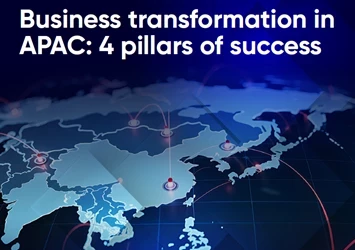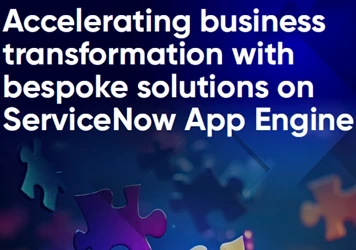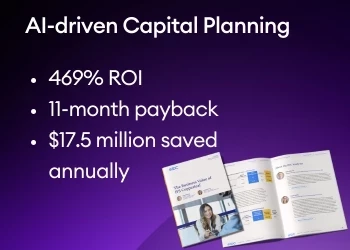Achieving OPEX in the financial services sector
Why investing in the right culture and looking at business and processes holistically are key for OPEX
Add bookmark
PEX Network caught up with Vinod Srinivasa, operational excellence (OPEX) professional at a US-based multinational bank, to hear his thoughts on the challenges, solutions and future of OPEX in financial services. Srinivasa has extensive professional experience in the OPEX space and has worked to drive OPEX across a range of industries including infrastructure and construction, manufacturing, technology and now banking and financial services.
To uncover more expert insights on OPEX in financial services register for PEX Live: OPEX Financial Services 2022 taking place online on 19–21 July 2022.
PEX Network: How would you define OPEX? Would you like to share some success stories you have experienced?

Vinod Srinivasa: I have seen that operations are a critical function which converts ideas into reality and dreams into action. Hence, working processes and practices need to be at their best for businesses to get delivery right the first time or to be the first market mover or deliver at a market sensitive cost.
OPEX is the thread that unifies an organization’s functions and channels them to enhance efficiency in every aspect. OPEX professionals along with leadership should ingrain the excellence culture and mind-set to deliver nothing but excellence to all stakeholders.
As OPEX principles are industry agnostic, I would like to share a success story from the manufacturing sector. As we all know, painting is a finishing step and the outcome is determined by how the customer views it visually. Hence, aesthetics is of prominence and a key differentiator to the customer.
While I was reviewing the month-over-month consumption and associated expenses, I noticed that the painting data depicted was beyond the budget allocated for that process. As I took a deep dive and conducted Gemba walks, it became clear that painting is a multi-variable process, affected by factors such as paint configuration, paint applying method, operator skill and drying time among others. There was significant variability in process deployment and numerous non-value adding activities.
I started plugging the gaps, including training those performing the task, via the OPEX route while also beginning to report the daily consumption patterns along with cost related metrics to all internal stakeholders including leaders. As the adage goes “what gets measured, gets done”, within 60 days the process got streamlined and the operating expenses reduced by 30 percent.
Another success story from the services domain is the efficiency improvement of the associates who churn out volumes based on defined targets. Using multiple OPEX levers such as bottom quartile management, reviewing cyclicity and seasonality volume trends, processing time study, target re-base-lining and cross skilling, capacity was created that could absorb new tasks without adding any new full-time employees. This was a win-win for the business and stakeholders alike.
PEX Network: What is your top advice for financial services organizations looking to drive OPEX?
VS: Financial services organizations in pursuit of OPEX should do two things uniquely different to other companies: manage their business and operational processes holistically and invest in developing the right culture.
Financial services organizations should also adhere to a number of tactical tenets while driving OPEX. These tenets include challenging the process owner on the status quo, invoking pioneering technologies for process automation and deploying lean principles across the value chain. Other tenets include benchmarking metrics and processes, optimizing cost and reducing loss, a focus on risk mitigation through elimination and reduction and applying process management to keep customer maps at the nucleus of OPEX efforts.
PEX Network: What are the major challenges involved with financial services companies achieving OPEX and how can they be overcome?
VS: Ensuring leadership commitment to build an organization-wide culture of excellence and innovation remains the primary challenge. Businesses should ensure that OPEX activities are integral to their processes and not optional or an add-on that can be invoked on an ‘as-needed’ basis.
Firms must be open to adapting and embracing new technologies and new business models to remain relevant in a world of volatility, uncertainty, complexity and ambiguity (VUCA). Also, leveraging technology to transform business processes in a dynamic business environment with continuous regulatory changes is a significant challenge in and of itself.
There are several practices that can help companies overcome the above challenges when deployed. These include the creation of ideation platforms to provide much needed-impetus for minds to brainstorm and innovate as well as timed deep-dive studies from multiple lenses such as simplification, technology, automation, patent and risk assessment that generate ideas for further deliberation.
Businesses can also engage in end-to-end business transformation, with all departments’ processes working in unison and in line with organizational goals and priorities while deploying effective improvement metrics tagged to all levels of employees.
PEX Network: What key developments do you see happening in the OPEX space in the financial services sector over the next two years?
VS: Financial services is an environment characterized by strict regulations, unprecedented competition, mergers and consolidations, adoption of emerging technologies and ever-changing customer behavior. This makes the future more challenging and complex for financial services.
Devising products and services that keep customer journeys and maps at the center of OPEX efforts will lead to customer-centricity at its best. Financial organizations should embrace automation to increase the straight-through processing (STP), thereby reducing customer wait times and error inclusive manual processing.
Patenting the innovation outcomes to protect the intellectual property and safeguard the organization in the future is a likely course of action for financial institutions. Businesses will likely monetize the earlier patented ideas by creating solutions that solve customers’ problems.
We will also likely see an expanding of the horizon of OPEX for risk management, its controls and the automation around it. OPEX remains the most inclusive and objective driver of differentiation and should continue to be the core consideration in any organization. This is because it sees any challenges and gaps as opportunities for improvement and to deliver for customers and drive growth sustainably.
To hear more expert insights and advice on operational excellence in financial services, register for PEX Live: OPEX Financial Services 2022, taking place online on 19–21 July 2022.
Do you agree that ensuring leadership commitment is a significant challenge when driving OPEX in financial services? Let us know in the comments below.
























